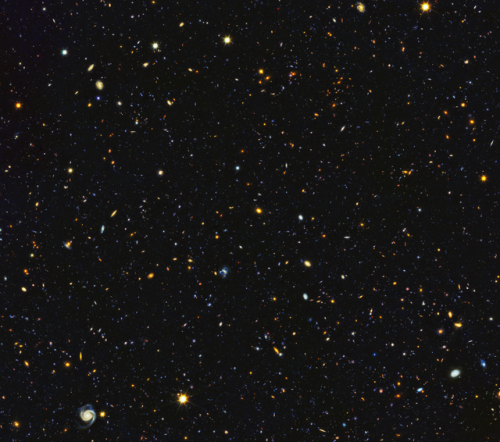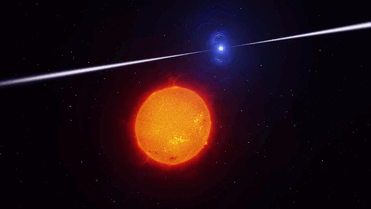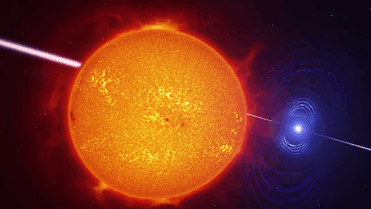(Source)








(Source)
More Posts from Ocrim1967 and Others










This Is What The Milky Way’s Magnetic Field Looks Like
“The Milky Way’s gas, dust, stars and more create fascinating, measurable structures. Subtracting out all the foregrounds yields the cosmic background signal, which possesses tiny temperature imperfections. But the galactic foreground isn’t useless; it’s a map unto itself. All background light gets polarized by these foregrounds, enabling the reconstruction of our galaxy’s magnetic field.”
Have you ever wondered what our galaxy’s magnetic field looks like? As long as we restrict ourselves to looking in the type of light that human eyes can see, the optical portion of the spectrum, we’re extremely limited as far as what we can infer. However, if we move on to data from the microwave portion of the spectrum, and in particular we look at the data that comes from the polarization of background light (and the foreground light directly), we should be able to reconstruct our galaxy’s magnetic fields to the best precision ever. The Planck satellite, in addition to mapping the CMB to better precision than ever before, has enabled us to do exactly that.
Even though there are still some small questions and uncertainties, you won’t want to miss these incredible pictures that showcase just how far we’ve come!
5 Ways the Moon Landing Changed Life on Earth
When Neil Armstrong took his first steps on the Moon 50 years ago, he famously said “that’s one small step for a man, one giant leap for mankind.” He was referring to the historic milestone of exploring beyond our own planet — but there’s also another way to think about that giant leap: the massive effort to develop technologies to safely reach, walk on the Moon and return home led to countless innovations that have improved life on Earth.
Armstrong took one small step on the lunar surface, but the Moon landing led to a giant leap forward in innovations for humanity.
Here are five examples of technology developed for the Apollo program that we’re still using today:
1. Food Safety Standards
As soon as we started planning to send astronauts into space, we faced the problem of what to feed them — and how to ensure the food was safe to eat. Can you imagine getting food poisoning on a spacecraft, hundreds of thousands of miles from home?
We teamed up with a familiar name in food production: the Pillsbury Company. The company soon realized that existing quality control methods were lacking. There was no way to be certain, without extensive testing that destroyed the sample, that the food was free of bacteria and toxins.
Pillsbury revamped its entire food-safety process, creating what became the Hazard Analysis and Critical Control Point system. Its aim was to prevent food safety problems from occurring, rather than catch them after the fact. They managed this by analyzing and controlling every link in the chain, from the raw materials to the processing equipment to the people handling the food.
Today, this is one of the space program’s most far-reaching spinoffs. Beyond keeping the astronaut food supply safe, the Hazard Analysis and Critical Point system has also been adopted around the world — and likely reduced the risk of bacteria and toxins in your local grocery store.

2. Digital Controls for Air and Spacecraft
The Apollo spacecraft was revolutionary for many reasons. Did you know it was the first vehicle to be controlled by a digital computer? Instead of pushrods and cables that pilots manually adjusted to manipulate the spacecraft, Apollo’s computer sent signals to actuators at the flick of a switch.
Besides being physically lighter and less cumbersome, the switch to a digital control system enabled storing large quantities of data and programming maneuvers with complex software.
Before Apollo, there were no digital computers to control airplanes either. Working together with the Navy and Draper Laboratory, we adapted the Apollo digital flight computer to work on airplanes. Today, whatever airline you might be flying, the pilot is controlling it digitally, based on the technology first developed for the flight to the Moon.

3. Earthquake-ready Shock Absorbers
A shock absorber descended from Apollo-era dampers and computers saves lives by stabilizing buildings during earthquakes.
Apollo’s Saturn V rockets had to stay connected to the fueling tubes on the launchpad up to the very last second. That presented a challenge: how to safely move those tubes out of the way once liftoff began. Given how fast they were moving, how could we ensure they wouldn’t bounce back and smash into the vehicle?
We contracted with Taylor Devices, Inc. to develop dampers to cushion the shock, forcing the company to push conventional shock isolation technology to the limit.
Shortly after, we went back to the company for a hydraulics-based high-speed computer. For that challenge, the company came up with fluidic dampers—filled with compressible fluid—that worked even better. We later applied the same technology on the Space Shuttle’s launchpad.
The company has since adapted these fluidic dampers for buildings and bridges to help them survive earthquakes. Today, they are successfully protecting structures in some of the most quake-prone areas of the world, including Tokyo, San Francisco and Taiwan.

4. Insulation for Space
We’ve all seen runners draped in silvery “space blankets” at the end of marathons, but did you know the material, called radiant barrier insulation, was actually created for space?
Temperatures outside of Earth’s atmosphere can fluctuate widely, from hundreds of degrees below to hundreds above zero. To better protect our astronauts, during the Apollo program we invented a new kind of effective, lightweight insulation.
We developed a method of coating mylar with a thin layer of vaporized metal particles. The resulting material had the look and weight of thin cellophane packaging, but was extremely reflective—and pound-for-pound, better than anything else available.
Today the material is still used to protect astronauts, as well as sensitive electronics, in nearly all of our missions. But it has also found countless uses on the ground, from space blankets for athletes to energy-saving insulation for buildings. It also protects essential components of MRI machines used in medicine and much, much more.

Image courtesy of the U.S. Marines
5. Healthcare Monitors
Patients in hospitals are hooked up to sensors that send important health data to the nurse’s station and beyond — which means when an alarm goes off, the right people come running to help.
This technology saves lives every day. But before it reached the ICU, it was invented for something even more extraordinary: sending health data from space down to Earth.
When the Apollo astronauts flew to the Moon, they were hooked up to a system of sensors that sent real-time information on their blood pressure, body temperature, heart rate and more to a team on the ground.
The system was developed for us by Spacelabs Healthcare, which quickly adapted it for hospital monitoring. The company now has telemetric monitoring equipment in nearly every hospital around the world, and it is expanding further, so at-risk patients and their doctors can keep track of their health even outside the hospital.

Only a few people have ever walked on the Moon, but the benefits of the Apollo program for the rest of us continue to ripple widely.
In the years since, we have continued to create innovations that have saved lives, helped the environment, and advanced all kinds of technology.
Now we’re going forward to the Moon with the Artemis program and on to Mars — and building ever more cutting-edge technologies to get us there. As with the many spinoffs from the Apollo era, these innovations will transform our lives for generations to come.
Make sure to follow us on Tumblr for your regular dose of space: http://nasa.tumblr.com.

Astronomers have just assembled one of the most comprehensive portraits yet of the universe’s evolutionary history, based on a broad spectrum of observations by the Hubble Space Telescope and other space and ground-based telescopes. In particular, Hubble’s ultraviolet vision opens a new window on the evolving universe, tracking the birth of stars over the last 11 billion years back to the cosmos’ busiest star-forming period, about 3 billion years after the big bang. This photo encompasses a sea of approximately 15,000 galaxies — 12,000 of which are star-forming — widely distributed in time and space. This mosaic is 14 times the area of the Hubble Ultra Violet Ultra Deep Field released in 2014.
Credits: NASA, ESA, P. Oesch (University of Geneva), and M. Montes (University of New South Wales)
Scientists push back against Harvard 'alien spacecraft' theory

This photo released by the European Southern Observatory on November 20, 2017 shows an artist’s impression of the first interstellar object known to enter our solar system: ‘Oumuamua
A scientific paper led by two researchers at Harvard University made a splash this week by claiming that a cigar-shaped rock zooming through our solar system may have been sent by aliens.
The researchers noted in a pre-print of the article that it was an “exotic scenario,” but that “Oumuamua may be a fully operational probe sent intentionally to Earth vicinity by an alien civilization.”
Oumuamua, the first interstellar object known to enter our solar system, accelerated faster away from the Sun than expected, hence the notion that some kind of artificial sail that runs on sunlight—known as a light sail—may have helped push it through space.
“Currently there is an unexplained phenomena, namely, the excess acceleration of Oumuamua, which we show may be explained by the force of radiation pressure from the sun,” co-author and Harvard astrophysicist Shmuel Bialy told AFP via email Tuesday.
“However this requires the body to have a very large surface and be very thin, which is not encountered in nature.”
Their suggestion of an alien force at work went viral.
But other astronomy experts aren’t buying it.
“Like most scientists, I would love there to be convincing evidence of alien life, but this isn’t it,” said Alan Fitzsimmons, an astrophysicist at Queens University, Belfast.
“It has already been shown that its observed characteristics are consistent with a comet-like body ejected from another star system,” he told AFP.
“And some of the arguments in this study are based on numbers with large uncertainties.”
Read more ~ phys.org

A photo released by the European Space Agency on June 27, 2018 shows an artist’s impression of ‘Oumuamua Editor’s note: Any cometary outgassing required to provide acceleration would have been detectable. None detected. What kills the alien probe theory for me is it’s velocity. Fast enough to buzz through the solar system without being snared by the sun but WAY too slow for practical interstellar travel although it’s trajectory put it on a nice path for exploration.

Credit : NASA - https://www.nasa.gov/feature/jpl/small-asteroid-or-comet-visits-from-beyond-the-solar-system, Public Domain, https://commons.wikimedia.org/w/index.php?curid=64030370










What Is The Smallest Possible Distance In The Universe?
“At present, there is no way to predict what’s going to happen on distance scales that are smaller than about 10-35 meters, nor on timescales that are smaller than about 10-43 seconds. These values are set by the fundamental constants that govern our Universe. In the context of General Relativity and quantum physics, we can go no farther than these limits without getting nonsense out of our equations in return for our troubles.
It may yet be the case that a quantum theory of gravity will reveal properties of our Universe beyond these limits, or that some fundamental paradigm shifts concerning the nature of space and time could show us a new path forward. If we base our calculations on what we know today, however, there’s no way to go below the Planck scale in terms of distance or time. There may be a revolution coming on this front, but the signposts have yet to show us where it will occur.”
If you went down to smaller and smaller distance scales, you might imagine that you’ll start to see the Universe more clearly and in higher resolution. You’ll be able to hone in on the fundamental properties of nature, and glean more information the deeper you go. This is true, but only up to a point. Beyond that, you start running into the inescapable quantum rules that govern the Universe, and that means there’s a fundamental scale at which our best laws of physics cannot be trusted any longer.
That scale is the Planck scale, and for distances, it corresponds to about 10^-35 meters. It really is a problem for physics, and it’s high time you understood why.
Parker Solar Probe is Go for Launch
Tomorrow, Aug. 11, we’re launching a spacecraft to touch the Sun.

The first chance to launch Parker Solar Probe is 3:33 a.m. EDT on Aug. 11 from Space Launch Complex 37 at Cape Canaveral Air Force Station in Florida. Launch coverage on NASA TV starts at 3 a.m. EDT at nasa.gov/live.
After launch, Parker Solar Probe begins its daring journey to the Sun’s atmosphere, or corona, going closer to the Sun than any spacecraft in history and facing brutal heat and radiation.
Though Parker Solar Probe weighs a mere 1,400 pounds — pretty light for a spacecraft — it’s launching aboard one of the world’s most powerful rockets, a United Launch Alliance Delta IV Heavy with a third stage added.

Even though you might think the Sun’s massive means things would just fall into it, it’s surprisingly difficult to actually go there. Any object leaving Earth starts off traveling at about 67,000 miles per hour, same as Earth — and most of that is in a sideways direction, so you have to shed most of that sideways speed to make it to the Sun. All that means that it takes 55 times more launch energy to go to the Sun than it does to go to Mars. On top of its powerful launch vehicle, Parker Solar Probe will use seven Venus gravity assists to shed sideways speed.
Even though Parker Solar Probe will lose a lot of sideways speed, it’ll still be going incredibly fast as its orbit draws closer to the Sun throughout its seven-year mission. At its fastest, Parker Solar Probe will travel at 430,000 miles per hour — fast enough to get from Philadelphia to Washington, D.C. in one second — setting the record for the fastest spacecraft in history.

But the real challenge was to keep the spacecraft from frying once it got there.
We’ve always wanted to send a mission to the corona, but we literally haven’t had the technology that can protect a spacecraft and its instruments from its scorching heat. Only recent advances have enabled engineers to build a heat shield that will protect the spacecraft on this journey of extremes — a tricky feat that requires withstanding the Sun’s intense radiation on the front and staying cool at the back, so the spacecraft and instruments can work properly.

The 4.5-inches-thick heat shield is built like a sandwich. There’s a thin layer of carbon material like you might find in your golf clubs or tennis rackets, carbon foam, and then another thin piece of carbon-carbon on the back. Even while the Sun-facing side broils at 2,500 degrees Fahrenheit, the back of the shield will remain a balmy 85 degrees — just above room temperature. There are so few particles in this region that it’s a vacuum, so blocking the Sun’s radiation goes a long way towards keeping the spacecraft cool.
Parker Solar Probe is also our first mission to be named after a living individual: Dr. Eugene Parker, famed solar physicist who in 1958 first predicted the existence of the solar wind.

“Solar wind” is what Dr. Parker dubbed the stream of charged particles that flows constantly from the Sun, bathing Earth and our entire solar system in the Sun’s magnetic fields. Parker Solar Probe’s flight right through the corona allows it to observe the birth of the very solar wind that Dr. Parker predicted, right as it speeds up and over the speed of sound.

The corona is where solar material is heated to millions of degrees and where the most extreme eruptions on the Sun occur, like solar flares and coronal mass ejections, which fling particles out to space at incredible speeds near the speed of light. These explosions can also spark space weather storms near Earth that can endanger satellites and astronauts, disrupt radio communications and, at their most severe, trigger power outages.

Thanks to Parker Solar Probe’s landmark mission, solar scientists will be able to see the objects of their study up close and personal for the very first time.
Up until now, all of our studies of the corona have been remote — that is, taken from a distance, rather than at the mysterious region itself. Scientists have been very creative to glean as much as possible from their remote data, but there’s nothing like actually sending a probe to the corona to see what’s going on.

And scientists aren’t the only ones along for the adventure — Parker Solar Probe holds a microchip carrying the names of more than 1.1 million people who signed up to send their name to the Sun. This summer, these names and 1,400 pounds of science equipment begin their journey to the center of our solar system.
Three months later in November 2018, Parker Solar Probe makes its first close approach to the Sun, and in December, it will send back the data. The corona is one of the last places in the solar system where no spacecraft has visited before; each observation Parker Solar Probe makes is a potential discovery.
Stay tuned — Parker Solar Probe is about to take flight.
Keep up with the latest on the mission at nasa.gov/solarprobe or follow us on Twitter and Facebook.
Make sure to follow us on Tumblr for your regular dose of space: http://nasa.tumblr.com.


The Scorpii AR system
In the system AR Scorpii a rapidly spinning white dwarf star powers electrons up to almost the speed of light. These high energy particles release blasts of radiation that lash the companion red dwarf star, and cause the entire system to pulse dramatically every 1.97 minutes with radiation ranging from the ultraviolet to radio.
The star system AR Scorpii, or AR Sco for short, lies in the constellation of Scorpius, 380 light-years from Earth. It comprises a rapidly spinning white dwarf, the size of Earth but containing 200,000 times more mass, and a cool red dwarf companion one third the mass of the Sun, orbiting one another every 3.6 hours in a cosmic dance as regular as clockwork.
Read more at: cosmosmagazine & astronomynow










(Source)










Why 2020 Might Be The Best Geminid Meteor Shower Of All-Time
“As the large parent body of the Geminids, asteroid 3200 Phaethon, continues on its tight orbit around the Sun, it will continue to expel matter and be torn apart, bit by tiny bit. The asteroid is about the size of the one that struck Earth 65 million years ago, causing our last great mass extinction. But instead of colliding with us all at once, this ~6 km wide asteroid is slowly dissipating in the presence of the Sun, creating tails of matter and ions but also an ever-thickening debris stream.
With each mid-December that rolls past, Earth slams through that debris stream, creating a show that gets progressively more spectacular with each set of orbits that regularly tick by. Over the past 15 years, the Geminids have regularly been one of the two best displays of meteor showers on Earth, and it’s eminently possible that 2020 will set a new record. The Moon, the Earth, and all of the other predictable conditions are just right for a spectacular show. If the clouds cooperate on December 13 and 14, treat yourself to the greatest natural show of the year. With all that 2020 has brought us, we can all use a cosmic treat like this one.”
Can everyone just have a good thing to enjoy? Can we all just have something nice that we don’t have to fight over? Well, nature might deliver what humanity has been unable to bring us for 2020: a natural show that can’t be stopped by anything, except for clouds.
Get your Geminid fix today, and then look up on December 13/14 to fully enjoy the show!
Hilarious Animal Snapchats That Are Impossible Not To Laugh At




















-
 hibiskooks liked this · 1 month ago
hibiskooks liked this · 1 month ago -
 infantisimo liked this · 1 month ago
infantisimo liked this · 1 month ago -
 killjoy121710 reblogged this · 1 month ago
killjoy121710 reblogged this · 1 month ago -
 killjoy121710 liked this · 1 month ago
killjoy121710 liked this · 1 month ago -
 pastelprisma reblogged this · 1 month ago
pastelprisma reblogged this · 1 month ago -
 pastelprisma liked this · 1 month ago
pastelprisma liked this · 1 month ago -
 queerfairylightswizard reblogged this · 1 month ago
queerfairylightswizard reblogged this · 1 month ago -
 batsudreamy reblogged this · 1 month ago
batsudreamy reblogged this · 1 month ago -
 dancingafterdark liked this · 2 months ago
dancingafterdark liked this · 2 months ago -
 pintsofguinnesmakeyoustrong reblogged this · 2 months ago
pintsofguinnesmakeyoustrong reblogged this · 2 months ago -
 teambuckaroo reblogged this · 3 months ago
teambuckaroo reblogged this · 3 months ago -
 soup-4-life reblogged this · 3 months ago
soup-4-life reblogged this · 3 months ago -
 problemsynth reblogged this · 3 months ago
problemsynth reblogged this · 3 months ago -
 souptacular reblogged this · 3 months ago
souptacular reblogged this · 3 months ago -
 superfastsquiddle reblogged this · 3 months ago
superfastsquiddle reblogged this · 3 months ago -
 superfastsquiddle liked this · 3 months ago
superfastsquiddle liked this · 3 months ago -
 pennyful-dream liked this · 3 months ago
pennyful-dream liked this · 3 months ago -
 madmoonmoon reblogged this · 3 months ago
madmoonmoon reblogged this · 3 months ago -
 madmoonmoon liked this · 3 months ago
madmoonmoon liked this · 3 months ago -
 lokidokeyartichoki reblogged this · 3 months ago
lokidokeyartichoki reblogged this · 3 months ago -
 celerybeast reblogged this · 3 months ago
celerybeast reblogged this · 3 months ago -
 beautifulprincewithadisorder liked this · 3 months ago
beautifulprincewithadisorder liked this · 3 months ago -
 glitterhomunculus reblogged this · 3 months ago
glitterhomunculus reblogged this · 3 months ago -
 flipocrite reblogged this · 3 months ago
flipocrite reblogged this · 3 months ago -
 batsudreamy reblogged this · 6 months ago
batsudreamy reblogged this · 6 months ago -
 theanimatedpanda liked this · 10 months ago
theanimatedpanda liked this · 10 months ago -
 nxns3sne reblogged this · 1 year ago
nxns3sne reblogged this · 1 year ago -
 nxns3sne liked this · 1 year ago
nxns3sne liked this · 1 year ago -
 hopefulsoulmindtravel2 liked this · 1 year ago
hopefulsoulmindtravel2 liked this · 1 year ago -
 silly-artist liked this · 1 year ago
silly-artist liked this · 1 year ago -
 meisterabababa reblogged this · 1 year ago
meisterabababa reblogged this · 1 year ago -
 patloika liked this · 1 year ago
patloika liked this · 1 year ago -
 polkaretto liked this · 1 year ago
polkaretto liked this · 1 year ago -
 kings-of-the-highlands reblogged this · 1 year ago
kings-of-the-highlands reblogged this · 1 year ago -
 manebioniclegali reblogged this · 1 year ago
manebioniclegali reblogged this · 1 year ago -
 manebioniclegali liked this · 1 year ago
manebioniclegali liked this · 1 year ago -
 bioradavadi liked this · 1 year ago
bioradavadi liked this · 1 year ago -
 checontate liked this · 1 year ago
checontate liked this · 1 year ago -
 patlinessphen liked this · 1 year ago
patlinessphen liked this · 1 year ago -
 ladydevil414 reblogged this · 1 year ago
ladydevil414 reblogged this · 1 year ago